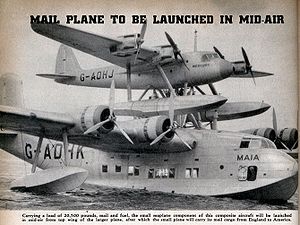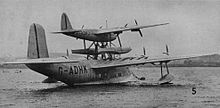Short Mayo Composite Video - Newsreel
|
|
Short Mayo Composite
S.20 Mercury

Picture - Image from a contemporary newspaper article, depicting Mercury atop Maia
Role: Transport seaplane carried to flight altitude by Short S.21 Maia
National origin: United Kingdom
Manufacturer: Short Brothers
Designed by: R. H. Mayo
First flight: 5 September 1937
Introduced: 14 July 1938
Retired: 1941
Primary users: Imperial Airways
RAF
Number built: 1
The Short Mayo Composite was a piggy-back long-range seaplane/flying boat combination produced by Short Brothers to provide a reliable long-range air transport service to the United States and the far reaches of the British Empire and the Commonwealth.
Development
Short Brothers had built the Empire flying boats which were capable of operating long range routes across the British Empire but could only attempt the trans-Atlantic route by replacing passenger and mail-carrying space with extra fuel.
It was known that aircraft could maintain flight with a greater load than is possible to take off with; Major Robert H. Mayo, Technical General Manager at Imperial Airways (and later a designer at Shorts) proposed mounting a small, long-range seaplane on top of a larger carrier aircraft, using the combined power of both to bring the smaller aircraft to operational height, at which time the two aircraft would separate, the carrier aircraft returning to base while the other flew on to its destination. The British Air Ministry issued Specification "13/33" to cover this project.
Design
The Short-Mayo composite project comprised the Short S.21 Maia, (G-ADHK) a design similar to the S.23 C class flying-boat, and the Short S.20 Mercury seaplane, the latter attached to a trestle-like pylon mounted on top of the fuselage of the former.
Although similar to the "C-Class" Empire boat, Maia differed in some considerable areas from that design: the sides were "tumblehome" rather than straight up to give a greater beam for better stability on the water; larger control surfaces; an increase in total wing area from 1,500 sq ft (140 m) to 1,750 sq ft (163 m) ; the engines were mounted further from the wing root to provide clearance for Mercury's floats and the fuselage was swept up towards the tail to raise the tailplane relative to the wing. Like the Empire boats, Maia could be furnished to carry 18 passengers. Maia first flew (without Mercury) on 27 July 1937, piloted by Shorts' Chief Test Pilot, John Lankester Parker.
The upper component, Mercury, was a twin-float, four-engine seaplane crewed by a single pilot and a navigator, who sat in tandem in a fully enclosed cockpit. There was capacity for 1,000 lb (456 kg) of mail. Mercury's flight controls, except for elevator and rudder trim tabs, were locked in neutral until separation. Mercury's first flight, also piloted by Parker, was on 5 September 1937.
All eight engines were used during combined flight but the controls of Mercury were locked. The airfoil designs of the two aircraft were such that Mercury's wings were carrying the major part of the air load at the speed and height chosen for separation. Safety locks prevented separation until this speed and height were reached and both pilots had an unlocking handle, both of which had to be pulled to cause release.
All eight engines were used during combined flight but the controls of Mercury were locked. The airfoil designs of the two aircraft were such that Mercury's wings were carrying the major part of the air load at the speed and height chosen for separation. Safety locks prevented separation until this speed and height were reached and both pilots had an unlocking handle, both of which had to be pulled to cause release.
Operations

Picture - Just before the first trans-Atlantic flight, August 1938
The first successful in-flight separation was carried out from the Shorts works at Borstal, near Rochester, Medway, on 6 February 1938, Maia piloted by Parker and Mercury by Harold Piper. Following further successful tests, the first transatlantic flight was made on 21 July 1938 from Foynes, on the west coast of Ireland, to Boucherville, Montreal, Canada, a flight of 2,930 miles (4,714.4 km). Maia, flown by Captain A.S. Wilcockson, took off carrying Mercury (piloted by Captain, later Air Vice Marshal Don Bennett), Mercury separating from the carrier aircraft to continue what was to become the first commercial non-stop East-to-West transatlantic flight by a heavier-than-air machine. This initial journey took 20 hrs 21 min at an average ground speed of 144 mph (232 km/h).
The Maia-Mercury composite continued in use with Imperial Airways, including Mercury flying to Alexandria, Egypt, in December 1938. After modifications to extend Mercury's range, it subsequently established a record flight for a seaplane of 6,045 miles (9,726.4 km) from Dundee in Scotland to Alexander Bay (in South Africa) between 6 and 8 October 1938.
Only one example of the Short-Mayo composite was built, the S.21 Maia with the registration G-ADHK and the S.20 Mercury (G-ADHJ). The development of a more powerful and longer-range Empire boat (the Short S.26), the further development of in-flight refuelling and the outbreak of the Second World War combined to render the approach obsolete. Maia was destroyed in Poole Harbour by German bombing on 11 May 1941. Mercury was flown to Felixstowe for use by 320 (Netherlands) Squadron RAF a Dutch seaplane reconnaissance unit serving with the Royal Air Force at RAF Pembroke Dock. When this squadron was re-equipped with Lockheed Hudsons, Mercury was returned to Shorts at Rochester on 9 August 1941 and broken up so that its aluminium content could be recycled for use in the war effort.
Operators
United Kingdom
Imperial Airways
Royal Air Force
No. 320 Squadron RAF
Specifications (S.20 Mercury)
Data from Barnes & James 1989 p.312
General characteristics
Crew: 2
Payload: 1,000 lb (454 kg)
Length: 51 ft (15.5)
Wingspan: 73 ft (22.2 m)
Height: 20 ft 3 in (6.17 m)
Wing area: 611 ft² (56.8 m²)
Empty weight: 10,163 lb (4,614 kg)
Loaded weight: 26,800 lb ()
Max takeoff weight: 15,500 lb (7,030 kg)
Powerplant: 4x— Napier Rapier VI 16-cylinder "H-block" piston engines, 365 hp (272.29 kW) each
* Normal composite launch weight: 20,800 lb (9,443 kg)
Record composite launch weight: 26,800 lb (12,160 kg)
Performance
Maximum speed: 212 mph (339 km/h)
Cruise speed: 195 mph (314 km/h)
Range: 3,900 mi (6,240 km)
Extended range: 6,100 mi (9,820 km) (Cape flight)
Specifications (S.21 Maia)
Data from Barnes & James 1989 p.312
General characteristics
Crew: 3
Capacity: 18
Length: 84 ft 11 in (25.9 m)
Wingspan: 114 ft (34.7 m)
Height: 32 ft 7½ in (9.95 m)
Wing area: 1,750 ft (162.5 m)
Empty weight: 24,745 lb (11,234 kg)
Loaded weight: 38,000 lb (17,252 kg)
Powerplant: 4x— Bristol Pegasus XC radial engine, 919 hp (686 kW) each
*Takeoff weight (composite): 27,700 lb (12,580 kg)
Performance
Maximum speed: 200 mph (332 km/h)
Range: 850 mi (1,360 km)
Service ceiling: 20,000 ft (6,100 m)
In popular culture
The children's novel The Sound of Propellors by Clive King follows the adventure of an Indian schoolboy who stows away on a fictional test flight from England to India, which is sabotaged by a German spy.
Related development
Short Empire
Short S.26
Jackson, A.J. (1974). British Civil Aircraft since 1919 Volume 3. London: Putnam. ISBN 0 370 10014 X.
Angelucci, Enzo (1984). World Encyclopedia of Civil Aircraft. London: Willow Books. ISBN 0-00-218148-7.
Composite Aircraft Flight 1935
The Great Experiment Flight 1937
Short Mayo Composite Pictures
Living Warbirds: The best warbirds DVD series.
Source: WikiPedia